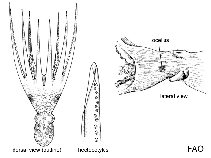Octopus maya Voss & Solis Ramirez, 1966
Mexican four-eyed octopus| Native range | All suitable habitat | Point map | Year 2050 |

|
| This map was computer-generated and has not yet been reviewed. |
| Octopus maya AquaMaps Data sources: GBIF OBIS |
رده بندی / Names اسامي عام | مترادف | CoL | ITIS | WoRMS
Cephalopoda | Octopoda | Octopodidae
Environment: milieu / climate zone / تغييرات عمق / distribution range بوم شناسي
; تغييرات عمق 0 - 100 m (مرجع 83938). Tropical; 23°N - 16°N, 98°W - 86°W (مرجع 96968)
Distribution كشورها | مناطق سازمان خوار و بار جهاني (FAO) | Ecosystems | ظهور | معرفي
Western Central Atlantic: Endemic to Mexico.
Length at first maturity / Size / Weight / سن
بلوغ: Lm 12.4 range ? - ? cm Max length : 12.0 cm ML جنس نر / بدون خواص جنسي; (مرجع 96968); بيشينه وزن گزارش شده: 5.0 kg (مرجع 96968)
Life cycle and mating behavior بلوغ | تولید مثل | تخم ریزی | Eggs | Fecundity | Larvae
مآخذ اصلی
مراجع | هماهنگ كننده | همكاران
Roper, C.F.E., M.J. Sweeney and C.E. Nauen 1984 FAO Species Catalogue. Vol. 3. Cephalopods of the world. An annotated and illustrated catalogue of species of interest to fisheries. FAO Fish. Synop. 125(3):277p. Rome: FAO. (مرجع 275)
وضعيت در فهرست قرمز IUCN
(مرجع 130435: Version 2025-1)
وضعيت از نظر سايتس (مرجع 108899)
CMS (مرجع 116361)
خطر برای انسان ها
استفاده انسانی
ماهي گيري – شيلات: تجاري
FAO - ماهي گيري – شيلات: landings | FishSource | Sea Around Us
ابزارها
اطلاعات بيشتر
منابع اينترنتي
BHL | BOLD Systems | CISTI | DiscoverLife | FAO(ماهي گيري – شيلات: ; publication : search) | Fishipedia | GenBank (ژنوم, نوکلئوتيد) | GloBI | Gomexsi | Google Books | Google Scholar | Google | PubMed | Tree of Life | Wikipedia (برو, جستجو) | Zoological Record



